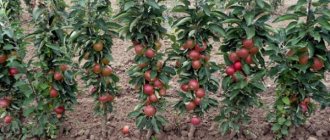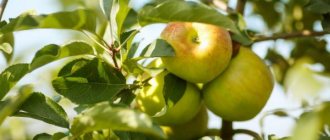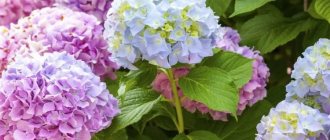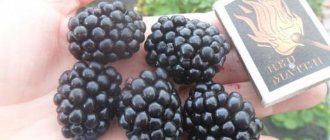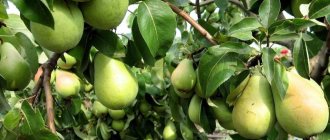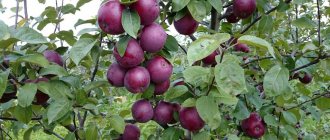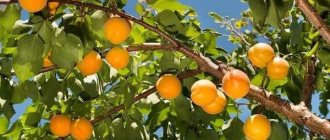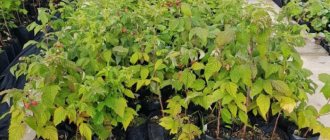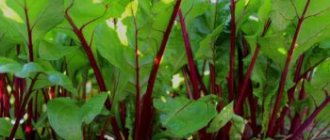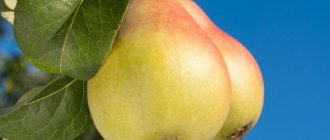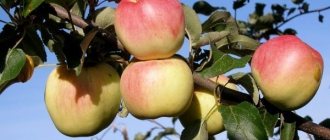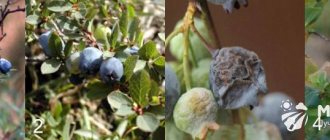Columnar apple tree is a natural clone of an apple tree that does not have side branches. In British Columbia, in the village of Kelowna (located in Canada), an unusual branch was found on an old McIntosh apple tree, which was 50 years old, or rather, it had an unusually large amount of foliage and fruits and there were no side branches at all. This happened in 1964. This spontaneous mutation did not go unnoticed by breeders and was propagated. Over time, with the help of it, experts created columnar apple trees. At the same time, both English breeders from Kent and specialists from other countries worked on this plant. In 1976, the first samples of this type of apple tree were obtained.
Features of a columnar apple tree
Scientists have found that such unusual characteristics of the columnar apple tree directly depend on the special Co gene. In these plants, the branches extend from the trunk at an acute angle, and they grow almost along the conductor. In this regard, such apple trees are similar in appearance to pyramidal poplars. Such an apple tree has a thickened trunk on which many small branches grow, and flower buds are located at their tops. The skeletal branches of simple apple trees are much more powerful than the lateral branches of columnar apple trees. Often they are replaced by spears, fruits or ringlets. The shoots of such a plant are quite thick, and they have shortened internodes. Dwarf varieties are less prone to branching compared to medium-sized varieties (1.5-3 times) and tall varieties (3-4 times). After the tree is 3–4 years old, its side branches stop growing. In the event that the apical bud is injured, the plant’s growth will stop, but the side branches will begin to actively grow. In this regard, those gardeners who want to grow a columnar apple tree must do everything to ensure that the plant’s growth point is maintained at least for the first 2 or 3 years. Such an apple tree will begin to bloom and bear fruit at the 2nd or 3rd year of life. The harvest in the first 5–6 years becomes more abundant every year, but already from the 7th–8th year of the plant’s life it is consistently high, but this is only the case when the apple tree is properly cared for. A columnar apple tree bears fruit for no more than 15–20 years; after this period, most of the ringlets die off. But if you are growing strong or medium-growing varieties or a tree that has been grafted onto seed rootstocks, then in these cases anti-aging pruning can be used, which can significantly extend the life of the apple tree.
Apple trees such as columnar ones are ideal for owners of small gardens. So, instead of one ordinary apple tree, you can plant several dozen columnar ones. There are 2 different types of columnar apple trees:
- varieties that have the Co gene;
- simple varieties that were grafted onto superdwarf clonal rootstocks (they are formed as columns).
Columnar apple tree. How to avoid fakes?
Trimming and shaping
Most often you can see columns with one trunk, but some experts recommend forming a tree with two or even three trunks. This is necessary in regions with cold winters in order to insure in case the apical bud of one of the trunks freezes out.
To prevent the tree from losing its shape, it is necessary to prune regularly. This procedure begins to be performed when the seedling reaches two years of age. Since the tree grows from the apical bud of the trunk, and strong branching is not necessary, it is not advisable to form a crown. All pruning consists of shortening the side shoots in the spring and simply regulating their growth in the future.
Planting columnar apple trees
What time to plant
Experts advise planting this kind of apple tree in the spring, but you need to have time to do this before the buds begin to open. If desired, you can plant a seedling in open ground in the autumn in the last days of September or the first days of October, the main thing is that the weather is warm. For planting, it is recommended to purchase annual seedlings rather than biennial ones. The fact is that such plants take root relatively easily and begin to grow and bear fruit much faster. When choosing a seedling, you need to pay special attention to its roots, so there should be no rot on them. Trees with overdried roots should also not be purchased. It is best to buy a seedling in a container; it can be planted even in the summer. A suitable area should be open and sunny, but it should be remembered that such an apple tree requires protection from strong gusts of wind. The soil needs to be saturated with nutrients and well-permeable to water. Groundwater on the site must lie at a depth of at least 200 centimeters.
Planting a columnar apple tree in autumn
If you decide to plant a large number of columnar apple trees at once, they should be arranged in rows. Thus, the distance between seedlings in a row should be at least 50 centimeters, while the row spacing should be 100 centimeters. Planting holes, which must be at least 90x90x90 centimeters in size, must be prepared half a month before planting. If this is not done, then after planting and settling the soil, the root collar will be located underground, and this can lead to the death of the seedling.
When digging a hole, you need to discard the top layer of soil, which contains a larger amount of nutrients, separately from the bottom layer, preventing them from mixing. If the soil is heavy, then at the bottom of the hole it is necessary to place a layer of crushed stone mixed with sand for drainage. After this, add 3 to 4 buckets of humus (compost), 100 grams of superphosphate and 50 to 100 grams of potassium fertilizer into the fertile soil and mix everything. It is also recommended to add 100 to 200 grams of dolomite flour into acidic soil. This soil must be poured into the planting hole and its surface leveled. After half a month, the soil will settle and become compacted.
After 2 weeks, you need to pour the remaining soil mixture into a heap into the planting hole. After this, you need to install the root system of the apple tree directly on this “hill” so that the root collar of the seedling rises slightly above the surface of the area. After the roots are straightened, you need to pour infertile soil (from the bottom layer) into the hole and compact it well. Step back 30 centimeters from the trunk and form a roller around it, the height of which should be from 10 to 15 centimeters. The planted tree should be watered, using 10–20 liters of water. After the liquid is absorbed into the soil, its surface should be sprinkled with a layer of mulch (sawdust, peat or chopped grass). If desired, you can install a support next to the seedling and tie it up.
How to plant a columnar apple tree in spring
If the planting of columnar apple trees is planned for the spring, then it is recommended to prepare the planting holes in the autumn. During the winter, the soil will settle, become compacted, and the applied fertilizers will dissolve. Apple trees planted in such holes take root much faster, and they may even bloom in the same year. You need to plant a seedling in the spring in the same way as in the fall.
Planting a columnar apple tree
Variety selection criteria
There are several conditions that a columnar apple tree variety must meet for planting in the Moscow region. Here are some of them:
- The apple tree should easily tolerate frosts even down to -30 degrees.
- Immunity to various diseases will be an important condition, because the climate contributes to the appearance of fungal diseases.
- The tree needs to withstand the summer heat.
- It is better to choose those trees that bear fruit every year.
A correctly selected variety will feel comfortable in the Moscow region. In this area, columnar apple trees have time to accumulate sugars.
Caring for columnar apple trees
Care in spring
In spring, it is necessary to prune apple trees and treat them for the purpose of prevention against various harmful insects and diseases. You need to have time to perform these procedures before the kidneys open. At the same time, fertilizers containing nitrogen must be added to the soil.
From apple trees planted this year, you need to pick off all the buds that form. In plants of the second year of life, only 10 buds are left. Starting from the third year of life, the load on the tree should not be increased immediately, but gradually, so that 2 times more buds are left on the plant than the number of fruits that should ripen. So, on each fruit link there should be 2 inflorescences, and thinning is done again in the summer.
Also, columnar apple trees must be watered in a timely manner and the top layer of soil around the trunk must be loosened. However, in the case when the tree is grown on a columnar rootstock, the roots of the plant may be injured in the process of loosening the soil. In this case, it is recommended to tin the tree trunk circle rather than sprinkle it with a layer of mulch. To do this, you need to step back a quarter of a meter from the trunk and sow green manure grasses in a circle, which will need systematic mowing.
Summer care
By mid-June it is necessary to carry out complex fertilizing, for which mineral fertilizers are used. After the ovaries form, it will be necessary to thin them a second time. As a result, ½ of the ovaries should remain on the tree. After the fruits are similar in size to cherries, you need to make sure that there are only 2 ovaries in each inflorescence. When the apples are similar in size to a walnut, you need to remove one of the two remaining ovaries. As a result, only 1 fruit should grow on 1 fruit-bearing link.
In the summer, do not forget to carry out preventive inspections of apple trees. If any harmful insects are found or the plant becomes sick, then it is simply necessary to take timely measures to treat it or get rid of pests, otherwise you may be left without a harvest. 4 weeks before the scheduled date of fruit harvest, all treatments of the plant against harmful insects and diseases should be stopped.
With the onset of August, organic fertilizers, as well as those containing nitrogen, cease to be applied to the soil. At this time, it is recommended to apply only potassium fertilizers to the soil, because they promote faster ripening of young shoots. To ensure that the upper parts of the shoots do not suffer from frost in the winter, it is necessary to shorten the 4 leaves located at the very top by 2/3.
Autumn care
In the autumn, when the fruits are harvested, it is necessary to add fertilizer to the soil and carry out treatment against harmful insects and fungi that have taken refuge in the bark, as well as inside the soil around the trunk. If necessary, it is necessary to prune for sanitary purposes, and then prepare the trees for wintering.
Processing columnar apple trees
At the beginning of the spring period (before sap flow begins) and in the autumn (when the leaves fall), these apple trees must be treated to prevent diseases and harmful insects. The surface of the tree trunk circle should also be treated. Most often, gardeners in this case use a solution of Nitrafen or Bordeaux mixture (1%). This treatment will help get rid of harmful insects and pathogens of various diseases that are found in the soil of the tree trunk and in the bark of the apple tree. There are those gardeners who use a urea solution (7%) for treatment in the spring, which acts as a fungicidal and insecticidal agent, as well as a nitrogen fertilizer.
Watering
Due to the fact that this kind of apple tree does not have a tap root, which goes deep into the soil, and at the same time the root system is surface and is located within a radius of a quarter meter from the trunk, then young plants need to be watered in the summer in normal weather once every 3 days . In dry and hot weather, columnar apple trees should be watered every day or once every 2 days. Watering mature plants should be carried out 1 or 2 times every 7 days. From the second half of June, watering is slightly reduced, and from the beginning of August these plants stop watering altogether, the fact is that they must have time to complete the formation of flower buds, as well as growth, and also prepare for wintering.
To prevent the soil from drying out too quickly and to prevent a dense crust on its surface, the tree trunk circle is sprinkled with a layer of mulch (straw) or it is seeded with green manure. It is recommended to water such apple trees using the drip method, and the supply of moisture to the root system should be dosed. However, once every 4 weeks it is necessary to water abundantly so that the soil can get wet to the depth at which the roots lie. Once every 2 weeks in the evening after the sun has set, you need to thoroughly water the crowns of the plants with a hose.
Fertilizer
Since this tree produces a very large number of apples, it absorbs a lot of nutrients from the soil. In this regard, such a plant should be fertilized throughout the entire period of intensive growth. In spring, organic fertilizers need to be added to the soil. For this purpose, both fermented chicken manure and slurry are used. In order for the tree to receive the required amount of nitrogen, you can spray it with a urea solution (7%), but this must be done at the beginning of the spring period, before the buds begin to open. After this, before the beginning of the second half of the summer period, if desired, the plants can be fed 2 more times using the foliar method and also use a urea solution (0.1%).
During the peak of intensive growth (from early to mid-June), trees need complex mineral fertilizers. From the beginning of August, organic fertilizers should no longer be used for fertilizing. During this period, columnar apple trees need potassium, as it promotes rapid ripening of the upper parts of the shoots.
Wintering columnar apple trees
At the beginning of the autumn period, the trunks of young columnar apple trees must be thoroughly covered with spruce branches or wood shavings. It should be remembered that only dry covering material should be used, and it should be protected from the penetration of rodents. You cannot cover plants with straw. If the tree trunk circle is mulched with straw, then it should be removed in the fall, because various rodents simply adore it. When the snow cover appears, you need to hill the base of the apple tree trunk with snow.
How I cover columnar apple trees for the winter
The best varieties for the Moscow region
Despite the cold climate, some varieties of columnar apple trees thrive in Moscow, Ryazan, Bryansk, Vladimir and other regions. For the most part, these are autumn and winter varieties that tolerate harsh winters well.
Malyukha
A young autumn variety included in the register in 2015. The apple tree is of medium height, the branches are thin, straight, brown in color and noticeably faceted. The leaves are small, smooth and shiny. They are dark green and tender. When compared with other varieties, the apples are small, only 64 grams. They are not the same size - they are slightly larger or smaller. Apples have a classic round-conical shape, and the funnel - the place where the “tail” of the apple is located - is deep and narrow. The color of the peel is from light green to light yellow. The baby has few subcutaneous points. When broken, the flesh is light cream with a slight sweetish aroma. It is juicy, like many autumn varieties, but it acquires the fullness of its sweet taste after 1–2 weeks of storage. Feels great in the Central region.
The Malyukha variety will delight you with small juicy sweet fruits
Triumph
Refers to autumn medium-sized varieties of apple trees. The crown looks like a narrow pyramid - it is not too dense, but not sparse. The bare apical shoots are strong and straight, with olive bark. The leaves are small and smooth, their dark green color slightly muted by dullness. The leaves are slightly curved upward along their axis and resemble a boat.
The fruits are round, weighing 120 g, seem smooth, but if you run your palm over the peel, you feel a slight ribbing . The color of the apple is greenish, but this is almost imperceptible. A red or brownish-red blush is blurred over the surface of the peel, which hides numerous green dots. The fruit has creamy flesh - rather sweet than sour, and the fine grain gives the apple a dense consistency and juiciness. This is a fairly young variety, entered into the register in 2015. Gardeners grow it not only in Central, but also in the Central Black Earth and in other, warmer regions of the country.
The Triumph variety was included in the register just 2 years ago
Vasyugan
The tree belongs to the autumn varieties. A medium-sized apple tree has a dense pyramidal crown - it seems that there are no gaps in the trunk. Brown-brown bare shoots are located very compactly, which is why the fruits are tightly pressed to each other. They are small, weighing 120 g, which is considered average. One tree can have fruits of different sizes. They are round in shape, narrower at the cup.
The apples are white in color, but you can’t tell by looking at the fruit. The white color is masked by a shy blush, which is evenly distributed over almost the entire surface of the peel and looks like a reddish blurry striped coating. Despite this, subcutaneous points are visible. They are gray, small, but there are few of them. The cut flesh is also white, dense in consistency, and crispy.
The taste of the apple is sweet and sour, slightly prickly. It smells faint, but pleasant. If the fruits sit for a while, they will become much tastier. The apple tree begins to bear fruit in the second year. It is not very resistant to winter frosts and drought. It is recommended to cover the tree for the winter. The variety now continues to undergo varietal testing in the Central region.
The peel of the Vasyugan variety is almost completely covered with a characteristic blush
The president
Entered into the register in 2004. This is an early winter variety belonging to medium-sized apple trees. It grows quickly and bears its first fruits in the third year.
The dense crown almost completely covers the trunk. Thick gray-green shoots are located close to each other, like the Vasyugan variety, so the tree is covered with fruits and sometimes needs to be rationed.
The apples are large - up to 310 g, regular in shape, reminiscent of a turnip, and of the same size. The surface of the fruit is ribbed, the color of the peel is whitish. Despite the light color of the peel, the gray subcutaneous dots are almost invisible. Perhaps this is due to the fact that there are few of them. The pulp is also white, with a medium-dense consistency. The apples are sweet and sour and juicy, but the characteristic aroma is weak. If you want to feel the real taste of these apples, you need to let them sit for 2 weeks. The variety has average resistance to drought and does not tolerate frost. Shelter for the winter will protect it from freezing. Gardeners in the Central region have already become convinced of the President’s yield and continue to grow it.
The President variety has a discreet but very attractive appearance
Moscow necklace
Low-growing winter variety. The leaves of the tree are large and wide. The apples are small, uniform in size, weighing up to 130 grams. The flesh of the fruit is white, crispy, but not too dense. It is sour-sweet, prickly - it seems that the tongue tingles slightly. After two weeks of storage, when the apples sit for a while, the taste becomes brighter and richer.
The color of the peel is greenish, but it is difficult to notice - the surface of the apple is filled with blush. Fruits in the second year. Included in the register of garden plants for the Central region in 2008. Winter hardiness is average, so it is better to cover the tree for the winter. Grows well throughout the Central region.
Moscow Necklace - a compact and productive apple tree
Ostankino
Medium-sized early winter variety with large wrinkled leaves. On the register since 2002.
It grows quickly - the shoots are thick and strong, gray-green in color with a slight edge. The first fruits appear after 1–2 years. They are round, slightly flattened, wide-ribbed, weighing up to 110 g. The apples are sweet and sour, juicy, very tasty. The flesh is greenish-white in color, contrasting with the bright skin. The apple is light yellow in color, but this is almost invisible - the main color is hidden under the rich blush, which is evenly spread over the peel. The fruits are very elegant, like liquid apples from a fairy tale. After storage for 2 weeks, their taste is fully revealed.
The variety is considered relatively resistant to all types of scab, but has high winter hardiness, which allows it to be grown in cold areas without fear. Feels great in all regions except the northern ones.
The bright and beautiful fruits of the Ostankino variety will not leave anyone indifferent
Experienced gardeners believe that seedlings no older than a year take root best.
Currency
Fast-growing, medium-sized, winter apple tree variety. The crown is dense. The shoots are medium-sized, green-brown, with medium-sized dark green leaves. The main color of the apple is light yellow, the outer color is orange-red, occupying part of the surface of the fruit. There are few subcutaneous points, they are poorly visible.
The apple pulp is white and juicy. It is sour-sweet, with a crunch. After storing for a week, it becomes brighter and more saturated. The aromatic fruits weigh from 130 to 240 g. They have a regular round-conical shape, the peel is smooth to the touch. It feels like they simply can't be real. The variety of this beauty is moderately resistant to drought, and you can taste the first fruits after 2 years. In the register since 2004, approved for cultivation in the Central region.
The Currency variety will delight you with good taste and yield
If groundwater in your area is located close to the surface, then it is better not to plant columnar varieties.
Pruning columnar apple trees
What time is pruning done?
A real columnar apple tree should not have branches; therefore, pruning to form the crown is not required. Only the side branches are pruned at the very beginning of the summer period or after all the leaves have fallen.
How to prune a columnar apple tree
You should remember one of the main principles of pruning an apple tree - the more branches you trim, the more intense their growth will be. So, for example, you cut a branch by about ½ part, and at the same time there were 3 or 4 eyes left on it. After some time, 3 or 4 strong shoots will grow from these eyes. If you cut off 1/3 of the branch and there are 7 or 8 eyes on it, then 7 or 8 medium shoots will grow from them. If pruning is done correctly, then every year the apple tree will grow by 10–15 centimeters, and 2 or 3 lateral buds will appear.
When you prune the branches, do not forget that you should not touch the central conductor. Otherwise, having lost its growth point, the tree will begin to actively grow branches.
At the beginning of spring, all the side branches of a tree of the first year of life should be cut off so that only 2 buds remain on each of them. In the next 2 or 3 years, it is necessary to form fruit links from young shoots. It is recommended to carefully trim those side shoots that are not needed while they are still green. The fact is that healing of wounds on woody shoots takes relatively longer.
Spring pruning
Pruning a columnar apple tree
Before sap flow begins, formative pruning should be done. For plants of the first year of life, all lateral branches must be pruned, leaving 2 buds on them. Sanitary pruning is also carried out, during which diseased, intersecting branches, as well as those affected by severe frosts in winter, are removed.
The tree of the second year of life is pruned to form fruit links. To do this, of the 2 shoots that grew on last year’s cut branch, you need to cut off the one that is more vertical, leaving only 2 buds on it. A horizontally located shoot will begin to bear fruit this year, and from a pruned shoot 2 powerful shoots will appear.
In the third year of life, those branches that bore fruit in the previous year must be removed. With the remaining branches, the same pruning procedure should be performed as last year. It should be remembered that the fruit link can function for no more than 3 or 4 years. After this period, it should be cut into a ring.
If the apical point of growth dies, it is recommended to trim the conductor, leaving only 2 buds. Wait until lateral branches grow from them. Of these branches, only 1 should be left, and it should be located vertically. This branch will become a replacement for the conductor. The remaining side branches must be cut into a stump (not into a ring), and the stumps must have the same length as simple ringlets.
Autumn pruning
In autumn, pruning should be done only when it is really necessary.
Summer ripening varieties
Representatives of this group will delight you with a harvest in mid-summer. Summer varieties reach full maturity by the end of August. These include:
- Nectar;
- Dialogue;
- The president.
Nectar
The Medoc apple tree got its name not by chance. The variety has very juice-rich pulp. It tastes sweet with a recognizable honey taste and smell. This is an early ripening sweet apple variety. The average amount of harvest obtained is about 8 kg per tree during the growing season. Although Medoc is a summer variety, it tolerates severe frosts very well. This apple tree is suitable for the northwest. She is not afraid of weather changes and sudden temperature changes.
Dialogue
Bright yellow apples with pulp rich in juice are characteristic of the Dialog species. Their size is small, but it is compensated by excellent taste characteristics and long storage. This variety loves good soil moisture and timely fertilizing.
Reproduction of columnar apple trees
To propagate columnar apple trees, the method of grafting a varietal cutting onto the rootstock that is most suitable is used. However, in order to successfully perform such a procedure, experience is required. You can also propagate by seeds, but this will take too much time and require a lot of effort. And not all apple trees that grow from seed are columnar. Experts advise propagating such a plant by air layering. Select a branch at the very beginning of spring, the thickness of which should be similar to a pencil. Then a circular cut of the bark is made at the base, the width of which should be 5 mm. After this, you need to moisten the cotton wool in Heteroauxin and wrap it around this incision for 24 hours. Next, moistened peat should be used to wrap the incision, while this place is covered with a black polyethylene bag, it is fixed so that no air gets under it. Do not let the peat dry out completely. In autumn, roots should grow at the site of the cut. After this, the branch is separated from the parent plant and planted in the soil. The probability of success of such reproduction is 50:50.
Growing seedlings of this type of apple tree is not an easy task. In this regard, it is recommended to buy them from trusted nurseries, and the seedlings must be transported correctly.
general characteristics
And first, about the columnar apple tree itself. Appeared relatively recently. 1964 is considered to be the year of the creation of the first variety of columnar apple tree called Vozhak .
It appeared as a natural mutation thanks to the care and interest of the gardener. He did not pass by a strange branch on a perennial McIntosh tree. Which caught his attention:
- Apples placed directly on top of each other tightly. But of the same variety;
- Heavy foliage and lack of lateral branches;
- Patience and work led to the development of the first variety. An amazing ability to experiment has led to the creation of more than 100 varieties of columnar apple trees;
- And our compatriots relatively quickly created dozens of varieties of columnar apple trees capable of delighting with harvests in difficult climatic conditions. Having high resistance to Russian frosts and diseases. In addition, the taste is not much inferior to traditional apples. But there are other valuable qualities;
- And the famous Russian scientist and breeder, Doctor of Sciences and Professor Viktor Valeryanovich Kichina, . Not just a hand. But also the mind. Modern Michurin. Creator of more than 20 varieties of apple trees. And in breeding raspberries, he has no equal - 25 varieties.
The first columnar apple tree Leader.
Advantages of columnar apple trees:
- Small crown forms - up to 3 m high and about 50 cm wide. And count how many of these trees you will plant instead of the vigorous Antonovka with its impressive forms. Many designers can no longer imagine a garden without columnar apple trees. Both in plantings and vases;
- Very fast entry into fruiting. Starting with 5-7 apples in the second year after planting. And annually 5-15 kg from 4-6 years of age;
- Large selection of varieties with high resistance to frost and disease;
- Small forms make caring for them more convenient in processing, pruning, and harvesting.
Don't forget about the disadvantages:
- Comparative high cost of seedlings;
- You won't be able to enjoy stable harvests for long. Only up to 15-16 years of age. This is their nature;
- If you forget about moisture and fertilizing, you won’t get even the minimum yield.
Pests of columnar apple trees
Columnar apple trees may well be inhabited by green and plantain aphids, sawflies, glass beetles, red mites, codling moths, moths, leaf rollers, copperheads, comma scale insects, currant, fruit and subbark leaf rollers, fruit and fruit moths, various cutworms, rowan moths, gypsy moths, oakleaf and ringed silkworms, blood and red gall aphids, goose weevils, western gypsy bark beetles, sapwood, pear pipeworms, as well as other pests. In the fight against harmful insects, you can use insecticidal agents, and catching belts made of corrugated paper are also useful (they prevent pests from going up the trunk).
Iksha
Autumn variety of columnar apple trees with high yield. The trees are low and compact. The fruits are round, yellowish in color with a striped blush. They taste sweet and sour, very juicy. Apple trees of the Iksha variety are resistant to many diseases and pests.
| Entry into fruiting | Tree height (m) | Fruit weight (g) | Harvest | Shelf life |
| For 1-2 years | 2 | 80-180 | End of August | 3 months |
Diseases of columnar apple trees
Such apple trees suffer from exactly the same diseases as ordinary ones. Most often, the columnar apple tree suffers from diseases such as: proliferation, or witch's broom, bitter fruit rot, mosaic, mosaic ringing, fly beetle, powdery mildew, milky sheen, tinder fungus, common cancer, scab, dying branches, fruit rot, subcutaneous viral spotting, rubberiness, rust, glassiness of fruits, flattened branches, black cancer and cytosporosis.
Diseases and pests: how to fight
The main apple disease that can destroy the crop is scab. After spring rains, its spores spread throughout the garden and infect trees in a matter of weeks. Dark spots with plaque appear on the leaves and fruits. To avoid scab, use fungicides and choose varieties that are resistant to it.
Wedge-shaped apple trees are also susceptible to other typical garden diseases - rot, fungus, spots, cancer, powdery mildew. Fungal diseases are treated according to one principle - quickly remove all damaged areas and treat with fungicides. Viruses like mosaic are often incurable, so the most important thing is to save the remaining trees.
The most common problem with any apple crop is the codling moth. Caterpillars eat everything in their path and can destroy up to half the crop. It is important to collect carrion every day, dig up the soil prophylactically and carry out seasonal spraying.
The apple flower beetle is a weevil that hides in the bark, and then its larvae eat the buds from the inside. The honeyweed sucks the juices from the leaves and shoots, which causes the tree to grow worse and lose productivity. Aphids hide on the back of leaf blades and on the tops of shoots. The most effective method in all these cases is specialized insecticides.
Main varieties with photographs and descriptions
The division of varieties is carried out depending on their growth, namely, they are divided into vigorous, medium-sized (semi-dwarf), and also dwarf. They are also divided according to the time of fruit ripening into late (winter), mid-season (autumn) and early (summer). Below are varieties divided by ripening time.
Summer varieties
On these plants, ripe apples can be harvested from the last days of July to the first days of September. Such fruits are eaten fresh or used to make preserves, jams, compotes, etc. The shelf life of such apples is relatively short.
The most popular varieties:
Nectar
This semi-dwarf variety is characterized by high yield and resistance to frost, diseases and harmful insects. Yellowish-white apples have a fairly thick skin, as well as juicy and grainy flesh with a distinct honey taste. On average, each apple weighs 100–250 grams. Plant height can vary from 200 to 250 centimeters.
The president
This semi-dwarf compact variety is characterized by high yield and resistance to frost, harmful insects and diseases. The fruits are very fragrant, pale yellow or pale green, in some cases they have a slight light pink blush. On average, apples weigh from 150 to 200 grams. The fine-grained pulp is juicy and tender.
Vasyugan
This productive variety is resistant to frost, harmful insects and diseases. The shape of the red-striped fragrant fruit is conical, the taste of the pulp is sourish-sweet, and it has clearly visible subcutaneous points. The cream-colored flesh is distinguished by its softness and juiciness. On average, the weight of the fruit is 140–200 grams.
Dialogue
The medium-sized variety is characterized by productivity and resistance to frost, pests and diseases. The deep yellow apples are not very large in size, but they are quite juicy. The shape of apples is flat.
Ostankino
The medium-sized variety is resistant to harmful insects and diseases. The fragrant, sour-sweet fruits have a light green color with a blush that has a fuzzy, blurry shape. Juicy apples can weigh from 100 to 220 grams.
Also quite popular among gardeners are such varieties as: Chervonets, Luch, Ideal, Raika, Flamingo, Gala, Cheremosh, Iksha, Green Noise, etc.
Autumn varieties
Fruit ripening on plants of these varieties occurs throughout the autumn period. They are eaten fresh or made into various preparations for the winter. Such apples are stored for a relatively short time (maximum until January). Popular varieties:
Malyukha
This dwarf variety is one of those that have the highest taste. The truncated-conical shape of dessert apples is large in size. They are painted orange-yellow or deep yellow and weigh from 150 to 250 grams. The durable, glossy skin is quite thin, and the yellow, fragrant flesh is fine-grained. This variety is high-yielding and early-bearing.
Gin
The variety is characterized by productivity and resistance to frost. The rich red fruits can weigh 80–200 grams. The sweet and sour pulp is firm and juicy. Apples can last until January.
Triumph
Medium-sized variety. The apples have a rich dark red color and have a striped blush on their surface. The shiny peel is quite dense. Snow-white crispy fine-grained pulp. It has a dessert sweet taste with a slight sourness. On average, apples weigh 100–150 grams.
Arbat
The variety is characterized by high yield and resistance to frost, harmful insects and diseases. The fruits ripen in the last days of September or the first days of November. Rich cherry color, medium-sized glossy apples with sour-sweet juicy flesh. The average fruit weight is from 100 to 120 grams.
Iedzen
This vigorous variety is resistant to scab and is winter-hardy. There are red streaks on the surface of yellow apples. The average fruit weight is 150 grams. The fine-grained, dense yellowish-green pulp has a sweet and sour taste. The taste is high.
Also quite popular are varieties such as: Kumir, Ladoga, Titania, Teleimon, Melba, etc.
Winter varieties
The ripening of apples of these varieties occurs in mid-autumn. They can last until spring. The following varieties are popular:
Amber necklace (amber)
The medium-sized variety is characterized by productivity and resistance to frost. Large greenish-yellow apples have a blush. The fine-grained, fragrant pulp is juicy and sour-sweet.
Currency
A medium-sized, early-fruiting variety, characterized by high yield, resistance to frost and scab. The fruits are large (weighing approximately 200 grams) and have a rich yellow color with a red side. The snow-white, sweet, juicy pulp is quite fragrant.
Moscow necklace
This self-sterile variety is characterized by high yield and resistance to frost, harmful insects and diseases. The fruits are quite large and dark red. The peel is dense. The sweet, juicy pulp has a slight sourness. On average, apples weigh about 170 grams.
Bolero
The fruits are large and their average weight is about 200 grams. The firm white flesh is juicy.
The most winter-hardy and drought-resistant varieties of columnar apple trees
Below we give a description of the best winter-hardy apple tree varieties. They are especially interesting for summer cottages located in areas with unfavorable conditions for gardening:
- In fifth place is the Gin variety, which has high winter hardiness, but only in the conditions of central Russia. The apple tree can withstand temperatures down to -25ºС, but requires mandatory shelter.
- Fourth place was shared by the Dialog and Amber Necklace varieties, because both are able to withstand low temperatures down to -30ºС. But the Dialog variety has a number of genetic defects that can affect survival in extreme conditions. To survive, the Amber Necklace apple tree requires strict adherence to the rules of care and shelter for the winter.
- The three most seasoned leaders are opened by the Moscow Necklace variety, which has winter hardiness at the level of Antonovka vulgaris. The latter is able to withstand frosts down to -38ºС. But the Moscow Necklace can withstand such cold weather only with abundant snow cover. If the winter promises to be snowless, then it is better to cover the apple tree.
- The Iksha variety takes second place in the ranking of the most winter-hardy varieties of columnar apple trees and deservedly so, because it is able to withstand frosts down to -40ºС. Moreover, this variety is extremely resistant to extreme weather conditions.
- The honorable first place is occupied by a variety that is well known to both gardeners in the Moscow region and gardeners in Siberia. So, the most winter-hardy variety of columnar apple trees is Vasyugan. This unique apple tree can withstand temperatures as low as -42 ºC.
In areas where winters are not so severe, but in the summer the sun burns out all living things, you should plant columnar apple trees that can hold water, preventing it from quickly evaporating. Drought-resistant varieties include Alluring Aroma, Dialogue, President, Currency.
The varieties of columnar apple trees Vostorg and Gin showed the greatest drought resistance in tests.
